Physical Address
304 North Cardinal St.
Dorchester Center, MA 02124
CT and MRI are commonly used to assess the extent and severity of disease in patients suspected of having pancreatitis, to evaluate for associated complications of pancreatitis, and to provide guidance for percutaneous drainage of peripancreatic fluid collections or percutaneous biopsy of pancreatic lesions. They are also useful to detect and characterize pancreatic lesions in patients at increased risk for pancreatic neoplasms, with symptoms or signs suggestive of pancreatic pathology, or with previously detected incidental pancreatic lesions on other imaging studies. In particular, MRI is often used as a problem-solving tool when an indeterminate pancreatic lesion is detected on other imaging studies, when the patient cannot receive iodinated contrast material for CT examination, or when the patient is pregnant. CT and MRI are also useful for the staging and pretreatment planning of patients with pancreatic malignancy (e.g., to determine the resectability of pancreatic malignancy), for response assessment of tumor following therapy, and for restaging assessment to detect recurrent tumor.
Given its superior soft tissue resolution, MRI is particularly useful for detection of cholelithiasis and choledocholithiasis, assessment of pancreatic duct disruption, identification of pancreaticobiliary developmental abnormalities (e.g., annular pancreas and pancreas divisum), improved assessment of pancreatic and peripancreatic fluid collections, improved detection and characterization of focal cystic or solid pancreatic lesions, particularly when small (<2 cm) in size, and assessment of iron deposition within the pancreas and other organs in the setting of primary (genetic) hemochromatosis.
MRCP is a noninvasive MR imaging technique that is performed through acquisition of very heavily T2-weighted images such that only fluid-filled structures, in particular the pancreaticobiliary tree, have very high signal intensity, whereas other background tissues and organs have very low signal intensity ( Figure 30-1 ). It is typically performed as part of a complete abdominal MRI examination, so that information about the surrounding soft tissues is also provided.
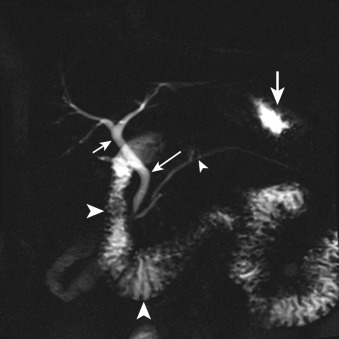
ERCP is an invasive technique that is performed by gastroenterologists during patient sedation by passage of an endoscope into the stomach and duodenum. It allows for direct visualization of the mucosa of the stomach and duodenum, direct visualization of the ampulla, and biopsy of lesions encountered. Contrast material is injected into the common bile duct and pancreatic duct, and then x-ray fluoroscopic images are acquired to create images of these ductal systems. Since the advent of MRCP, ERCP is performed less often for diagnostic purposes unless a therapeutic procedure is also planned such as removal of calculi, dilation of a sphincter, dilation of a stricture, or stent placement.
The pancreas is approximately 15 cm in length and 2 to 3 cm in width and is located within the anterior pararenal space of the retroperitoneum. It can be subdivided into the pancreatic uncinate process, head, neck, body, and tail. The pancreatic head is located to the left of the second portion of the duodenum, and the pancreatic body and tail are located posteriorly to the gastric body and antrum. In general, the pancreatic body and tail are slightly more superiorly located than the pancreatic head and uncinate process. Pancreatic size tends to decrease with increasing age. In younger people, the pancreas typically has a smooth contour and homogeneous attenuation, signal intensity, and enhancement ( Figure 30-2 ), whereas in older people, the pancreas typically becomes more lobulated and more inhomogeneous due to fatty change (which may be diffuse or focal). On MRI, the pancreas typically has the highest T1-weighted signal intensity among all abdominal organs (excluding abdominal fat).
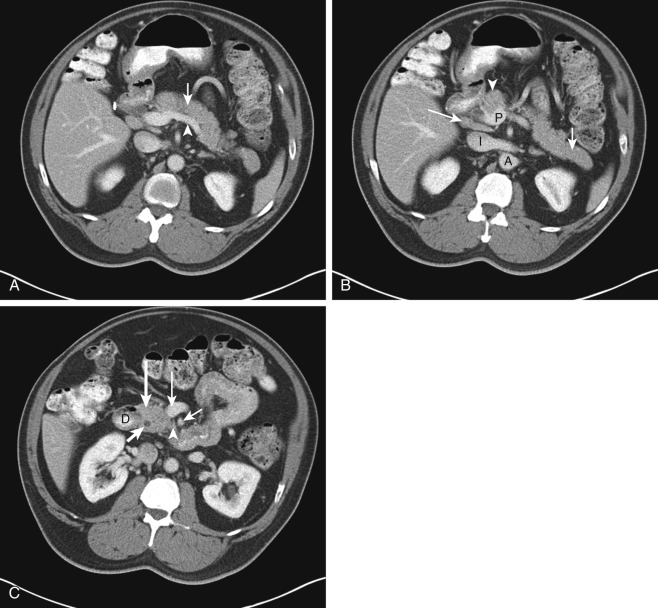
The main pancreatic duct is normally ≤ 2 to 3 mm in caliber but may measure up to 5 mm in caliber in elderly patients. The main pancreatic duct (of Wirsung) typically joins the common bile duct to form the ampulla of Vater and then drains into the second portion of the duodenum through the major duodenal papilla (of Vater). An accessory pancreatic duct (of Santorini) may occasionally be present more superiorly, which drains more superiorly and anteriorly into the second portion of the duodenum through the minor duodenal papilla. The common bile duct is typically located in the right posterolateral aspect of the pancreatic head (see Figure 30-2, C ). Approximately 20 to 35 short pancreatic ductal side branches join perpendicularly to the main pancreatic duct.
The splenic vein and artery are located posteriorly to the body and tail of the pancreas (see Figure 30-2, A ), where the former is larger in caliber, is less tortuous, and is more inferiorly located than the latter. The splenic vein is a reliable landmark to help identify the location of the pancreatic body and tail. The portal vein confluence (where the superior mesenteric [SMV] and splenic veins join), proximal SMV, and proximal superior mesenteric artery (SMA) pass posteriorly to the pancreatic neck and anteriorly to the uncinate process, where the proximal SMA is normally located posteriorly and to the left of the proximal SMV (see Figure 30-2, C ). The gastroduodenal artery (GDA) arises from the common hepatic artery and extends inferiorly along the anterolateral aspect of the pancreatic head.
The portacaval space is located between the main portal vein and inferior vena cava. Portacaval lymph nodes (see Figure 30-2, B ), the uncinate process of the pancreas, and an accessory or replaced right hepatic artery arising from the SMA may be seen in this location.
Pancreas divisum is the most common congenital anomaly of the pancreas, occurring in up to 15% of patients. It results from failure of the dorsal and ventral pancreatic anlagen of the ductal systems to fully fuse during development. The duct in the pancreatic body and tail (derived from the dorsal pancreatic anlage) drains into the duodenum through the accessory duct (of Santorini) and minor duodenal papilla, whereas the separate, more posteriorly and inferiorly located duct in the pancreatic head and uncinate process (derived from the ventral pancreatic anlage) joins the distal common bile duct and drains into the duodenum through the major duodenal papilla (of Vater). Some investigators believe that this anomaly may be associated with an increased incidence of recurrent idiopathic pancreatitis, although others believe that the association is incidental.
An annular pancreas is a rare congenital anomaly of the pancreas, where pancreatic tissue partially or completely surrounds the second portion of the duodenum. On cross-sectional imaging, pancreatic parenchyma will be seen to encircle the duodenum, sometimes with associated duodenal luminal narrowing ( Figure 30-3 ). Sometimes, there may be associated duodenal obstruction.
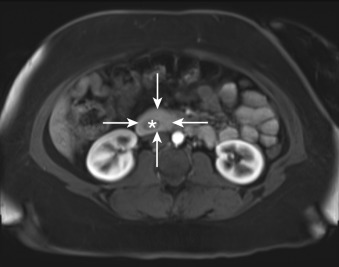
An intrapancreatic splenule is a congenital anomaly where an accessory spleen is located in the pancreatic tail. On CT and MRI, a 1- to 3-cm well-circumscribed structure is seen in the pancreatic tail that has similar attenuation, signal intensity, and enhancement properties as normal splenic parenchyma. It is asymptomatic and of no clinical significance, but awareness of this anomaly is of critical importance to prevent unnecessary surgical resection for a mistakenly suspected pancreatic neoplasm. A technetium-99m ( 99m Tc) heat-denatured red blood cell (RBC) scan or a 99m Tc sulfur colloid scan may be performed as needed to confirm this diagnosis, because splenic tissue will demonstrate uptake of these radiotracers ( Figure 30-4 ).
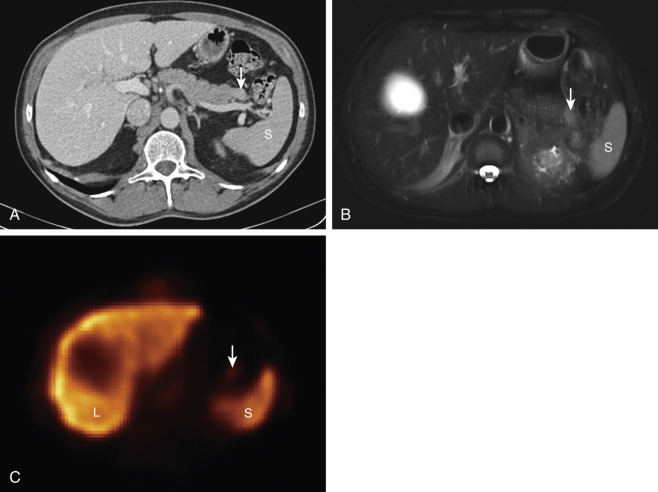
Fatty replacement, either diffuse or focal, can be seen with older age, cystic fibrosis ( Figure 30-5 ), diabetes mellitus, obesity, corticosteroid use, chronic obstruction of the pancreatic duct (such as by tumor or calculus), and prior pancreatitis. When focal, it can sometimes mimic a hypoattenuating pancreatic mass on CT. However, focal fatty replacement typically occurs in the anterior pancreatic head with a smooth well-demarcated border from a platelike or triangular higher attenuation area of fatty sparing in the posterior pancreatic head and uncinate process and generally remains stable over time ( Figure 30-6 ). Furthermore, there is preservation of the normal pancreatic contour and lobular appearance of the parenchyma, and no additional features of malignancy such as ductal obstruction, vascular encasement, lymphadenopathy, or metastatic disease are seen. On MRI, regions of focal fatty replacement have intermediate-high signal intensity on in-phase T1-weighted images with loss of signal intensity seen on out-of-phase T1-weighted images.
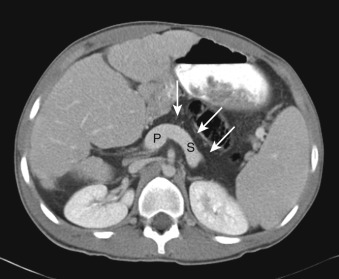
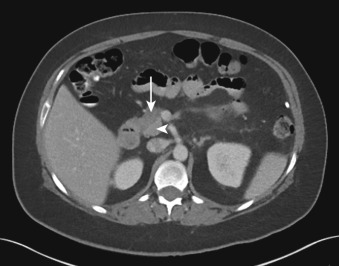
On MRI, iron deposition leads to low signal intensity of the pancreatic parenchyma on in-phase T1-weighted images compared to out-of-phase T1-weighted images. The major cause of pancreatic iron deposition is primary (genetic) hemochromatosis, which is an autosomal recessive disorder in which abnormal iron metabolism results in iron deposition in the liver and sometimes in the pancreas or myocardium. There is absence of iron deposition in the spleen or bone marrow, which instead would be seen in the setting of secondary hemosiderosis related to multiple blood transfusions, chronic hemodialysis, or hemolytic anemias.
CT is the mainstay of imaging evaluation of patients with acute pancreatitis, whereas MRI is more commonly used as a problem-solving tool. When performed, CT is typically obtained after 3 days from the onset of symptoms or when clinical findings worsen. Major indications for CT and MRI in this clinical setting are:
To confirm the clinical diagnosis of acute pancreatitis (if the diagnosis is uncertain) while simultaneously excluding other potential causes of acute abdominal symptoms and signs.
To assess the severity of acute pancreatitis involving the pancreas and peripancreatic tissues including the presence of complications.
To determine the underlying etiology of acute pancreatitis.
To guide treatment (e.g., percutaneous drainage of collections) and to monitor treatment response.
Alcoholism and gallstones are the most common causes of acute pancreatitis, accounting for 90% of cases in the United States. Less common causes include certain medications, chemicals, or toxins, abdominal trauma, ERCP, pancreatic tumors, hypertriglyceridemia, hypercalcemia, viral or parasitic infection, autoimmune disease, hereditary pancreatitis, and idiopathic pancreatitis.
Become a Clinical Tree membership for Full access and enjoy Unlimited articles
If you are a member. Log in here